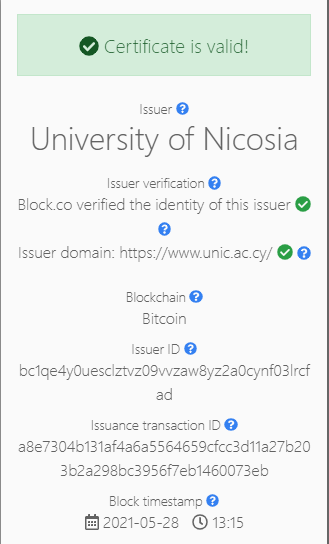DOCUMENT VERIFICATION SYSTEM USING BLOCKCHAIN TECHNOLOGY
THE STUDY OF THE LEGAL PROBLEM

Blockchain is a cryptographically secured, decentralized register of certain events on the basis of which a database is built, and each subsequent event affects its state. Blockchain technology provides the ability to authenticate documents sent physically. The use of multi-level authentication and signing of documents using Blockchain network is an innovative solution that opens new opportunities for secure and integral exchange of documents between different entities while ensuring their authenticity and invariability. The unquestionable advantage of using this solution is its decentralized character, allowing to omit the institution issuing the document and any other third parties, moreover:
– enables certainty of trading in electronic documents;
– facilitates auditing the institution (even remotely);
– prevents forgery of documents;
– makes it possible to track all modifications of a document over time; and
– ensures undeniable identification of the person/institution making each modification.
CERTIFICATION PROCESS
Initially, it is required that a specific entity, authenticating a specific document, generates a hash of the document, otherwise known as a digital fingerprint of a specific computer file. The hash represents an irreversible cryptographic hash. It is stored on the Blockchain so that all information is private and confidential. Then, a system is created which allows users who are connected with this entity by certain relations to verify the copy of the file they have with the hash placed in the Blockchain. The interested user may in this way authenticate the copy in his possession, if in the process of verification carried out e.g. on the website of the verifying entity the document copy fully complies with the hash.
PRACTICAL USE
This kind of open-source platform was created by the University of Nicosia. It has developed a system that allows users to verify respective documents. It is sufficient to have a copy of the document in a PDF file with special metadata, but this file itself is not stored on the platform. The metadata contained in this file allows the platform to determine whether the file actually originates from the issuer, in other words, whether the document was actually issued by the issuing entity. To do this, the PDF file must be uploaded to the specific site of the issuer where the certificate verification tool is located. Then, once the file is uploaded, the tool will display certain information about the user, certifying the authenticity of the document. This can happen only if the PDF file was issued directly by the issuing entity – only then will it contain metadata necessary for successful verification, activating Blockchain technology data authentication.

Sources:
- https://certifaction.io/diploma-certification/
- http://commonsign.eu/wp-content/uploads/2016/11/15_Technologia-blockchain-w-instytucjach-publicznych-w-Polsce_K.Piech_SGH.pdf
- https://newtech.law/en/the-hash-a-computer-files-digital-fingerprint/
- http://www.ijstr.org/final-print/mar2020/Educational-Certificate-Verification-System-Using-Blockchain.pdf
- https://www.blockchain-council.org/blockchain/document-verification-system-using-blockchain/
- https://www.unic.ac.cy/verify/
